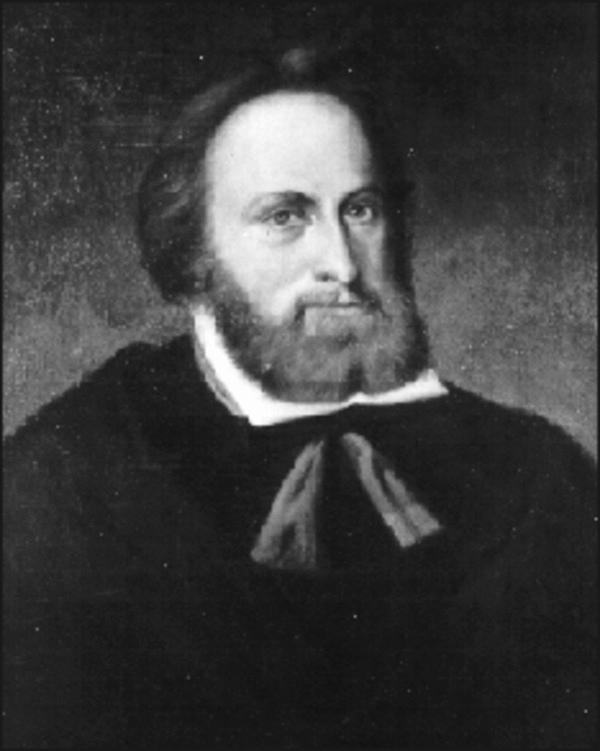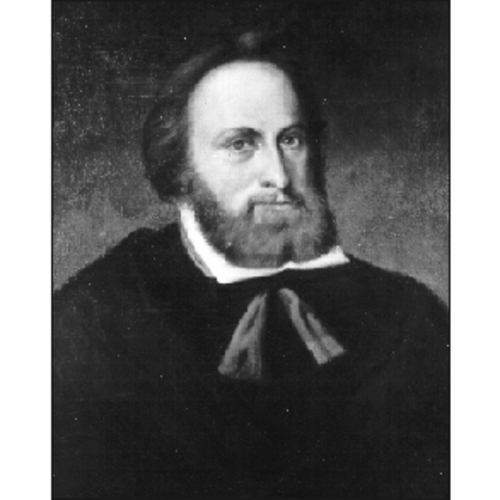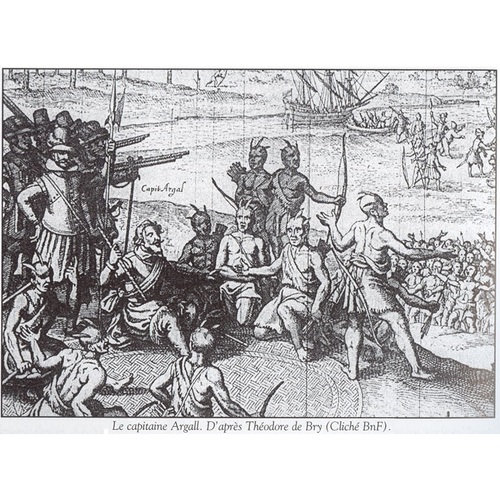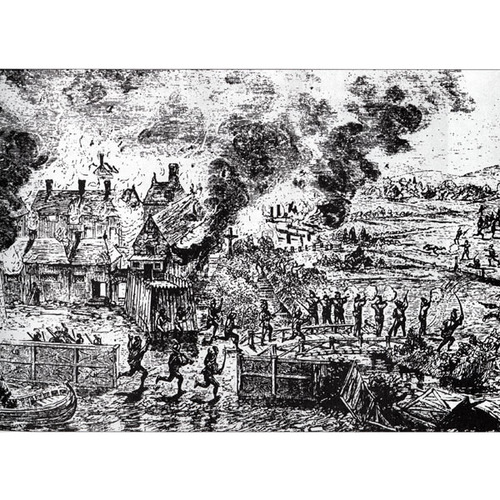
Source: Courtesy of Wikimedia Commons
ARGALL (Argoll), SIR SAMUEL, leader of the first English expedition to contest French settlement in Acadia; b. probably at East Sutton, Kent, England, and baptized 4 Dec. 1580. eighth son of Richard Argall, a military man of note of East Sutton, and his wife Mary, daughter of Sir Reginald Scott of Scott’s Hall, Kent; d. on or about 24 Jan. 1626.
James I in 1606 established by charter two Virginia companies, one of London and the other of Plymouth. The first company was to establish a permanent colony in eastern North America between latitudes 36º and 41ºN and the second between 38º and 45º. The Virginia Company of London established its settlement, Jamestown, and in 1609 received its confirming grant – sea to sea and 400 miles along the coast. The second company failed to found a settlement but its grant of 1606 was confirmed in the New England council grant of 1620. In the beginning all of this territory was called Virginia.
The records of the Guild of Merchant Tailors show that Capt. Samuel Argall was in the employ of the Virginia Company of London in 1609 and was commissioned to discover a shorter route to Virginia and to fish for sturgeon, valued for the caviar. He sailed west from the Azores to Bermuda and thence to the James River instead of going south to the tropics and west with the trade winds. His voyage took only nine weeks and six days including two weeks becalmed. This new route enabled the English to avoid the Spaniards and to save provisions. On his arrival at Jamestown, Argall found the new colony in dire straits. He supplied the colonists with all the food he could spare and returned to England at the end of the summer with a large catch of sturgeon. This help came to the colony at one of the most critical moments in its history.
Argall was back in Virginia in 1610 accompanied by Lord De La Warr and was appointed to the council by the governor. He was later driven off his course on a voyage to Bermuda, sailed and fished along the coast of New England to the mouth of the Penobscot on the coast of Maine. Charts of this coast which he made on this voyage were used later by Capt. John Smith and other voyagers.
In 1611 the Grâce de Dieu with Charles de Biencourt and fathers Biard and Massé on board en route for Port-Royal (now Annapolis Royal, N.S.) was driven into Newport, Isle of Wight, by severe weather. Although Lescarbot’s work on New France had been translated into English and was available in London in 1610, this new evidence that French colonization was continuing near or in the territory granted to the Virginia Company and that the Jesuits were taking part alarmed the company. As a result the Trinity term of the Virginia court, acting under the authority granted them by James I, named Capt. Argall admiral of Virginia and he was commissioned by the governor under authority of the Great Seal of England to expel the French from all the territory claimed by England. Argall left for Virginia on 23 July 1612, in the Treasurer, a vessel of 130 tons mounting 14 guns and carrying 60 men. This vessel was owned jointly by Sir Robert Rich, later Earl of Warwick, and himself. In the spring of 1613 Argall sailed up the Potomac and abducting Pocahontas, the Indian chieftain’s daughter who had befriended the colony, took her a prisoner to Jamestown to secure the release of eight Englishmen held prisoners by her father Powhatan. Early in June he sailed north to investigate the reported French settlement.
In the meantime there was much discord in Port-Royal between the Jesuit fathers Biard and Massé, and Jean de Biencourt de Poutrincourt and his son Charles. Word of this strife reaching France, the Marquise de Guercheville, one of the chief ladies at the French court, equipped and sent out a relief expedition consisting of two vessels, Jonas of 100 tons and a pinnace of 12 tons under René Le Coq de La Saussaye, to remove fathers Biard and Massé from the Port-Royal colony. Le Coq had a commission to settle on the coast to the south, which had been granted to Mme de Guercheville by the King of France. He reached Port-Royal in May 1613, took Biard and Massé on board, then sailed south to the Penobscot, and began to build a settlement named Saint-Sauveur.
Here Argall discovered them in July before they had fortifications erected. Their vessels were easily captured, as most of the French were ashore working on the settlement, and when Argall landed a small force some of them surrendered and the others fled into the woods. Several were killed including Gilbert Du Thet, a Jesuit lay-brother. According to Biard, Argall searched Le Coq’s chests, found his commission, concealed it, and treated the French thereafter as pirates. According to evidence given at an inquiry in England in 1614 Argall made the French three offers. He would (1) give them the small pinnace and enough food to take them to France, (2) give them passage to the fishing banks where they might meet French shipping, or (3) give Le Coq a shallop to make his own way with as many men as he would choose and to carry the rest to Virginia (BM, Cotton ms Otho E. VIII, 84, ff.252f). The third course was followed. Father Massé went with Le Coq and they met a French fishing vessel and returned to France. Fathers Pierre Biard and Jacques Quentin, Capt. Fleury of the Jonas, and La Motte-le-Vilin were among the 14 carried prisoners to Jamestown.
The council in Virginia decreed that Capt. Argall should sail immediately with his small fleet, the Treasurer and the two French vessels which he had captured, taking several of the French prisoners including Father Biard with him, and should destroy all the other French settlements to the north – to 46º according to Champlain (Works (Biggar), IV, 20) or 46 1/2º, according to Biard (JR (Thwaites), IV, 35). Landing first at Saint-Sauveur, he destroyed the remnants of La Saussaye’s settlement, cut down the cross planted by the Jesuits, and replaced it with one bearing the name of the king of England. He then proceeded to Sainte-Croix where he destroyed the remains of the old settlement and took a supply of salt stored there by French fishermen. Biard stated that he refused to guide Argall to Sainte-Croix but that he managed to find it anyway. He then steered across the bay to Port-Royal. Biard wrote that an Indian, the local sagamo, was captured by the English and guided them but Poutrincourt placed all the blame on Father Biard. No one suggests the obvious that there must have been enough charts and written directions in Le Coq’s baggage and on the Jonas to guide Argall to both Sainte-Croix and Port-Royal. At any rate the surprise was complete. Biencourt had gone off with the Indians foraging for food and left neither sentinels nor anyone to man the fort. Argall looted the settlement of everything he wanted, butchered some of the livestock, and carried other animals off alive, then burned the settlement to the ground except for the mill and a few isolated barns. He also destroyed the crops in the fields.
Biencourt returned as the English were about to set sail and met privately with Argall on the shore. Argall blamed the Jesuits for causing the governor of Virginia to order the attack and Biencourt demanded the surrender of Biard to be hanged. An anonymous English authority (in Purchas, Pilgrimes, XIX (1906)) claimed that Biencourt offered to go over to the English if permitted to remain at Port-Royal under English protection and that Argall refused the offer. There seems to be no confirmation of this statement among other authors.
Argall’s fleet left Port-Royal 13 November and almost immediately ran into a terrific storm. Argall in the Treasurer made his way back to Virginia stopping on the way, according to some authorities, to compel the small Dutch colony at the mouth of the Hudson to acknowledge English rule. The smallest vessel was never heard from again. Jonas with Lieut. Turner in command and with fathers Biard and Quentin on board was driven to the east and after stopping at the Azores for water and supplies made Pembroke in Wales. At the intervention of the French ambassador the Jesuits were permitted to return to France.
When Argall returned to England in 1614 there was an inquiry into his attacks on the French and it was agreed that the whole action was legal and proper to protect the rights granted to the Virginia Company by the Crown. The vessel Jonas was returned to Mme de Guercheville but her claim for 100,000 livres damages was disallowed.
Capt. Argall continued in the service of the Virginia Company and was elected deputy governor in 1616 and ruled the colony in the absence of the governor until 1619. The laws of the colony were severe as it was necessary to restrain the kind of settlers brought out at that time and Argall, finding the colony in disorder, enforced them harshly. Mostly for this reason many complaints went to London about him charging among other things extortion, waste of company revenues, and oppression of individuals. While Argall was in Virginia the Earl of Warwick sent the Treasurer under another captain on a roving mission to the West Indies and as a result of this Argall was also charged with piracy but even in the eyes of the Spaniards he was exonerated.
The many references to Argall which show him up as a tyrant and a villain are based on these charges as written in the minutes of the Virginia colony by his bitter enemy Sir Edwin Sandys; they neglect all the evidence which refuted the accusations, especially a long inquiry after Argall’s return to England in 1619 which exonerated him. On the other hand Father Biard who had the greatest reason to be bitter against him spoke very highly of him and obviously admired him.
While this inquiry was in progress he went on to further honours and greater responsibilities. In 1620 he was captain of a 24-gun merchant vessel and took part in an expedition against Algiers. On his return from the Mediterranean he was made a member of the Council of New England. He was very regular in his attendance at meetings of the council and actively interested in the colonization of this area. Later he was named admiral for New England. On 26 June 1622, he was knighted by King James. In 1624 he was nominated but not elected governor of Virginia and in the same year the king made him a member of his war council. In midsummer of 1625 he was the admiral of a fleet of 28 vessels which took many prizes off the coast of France and in October commanded the flagship in an unsuccessful attack on Cadiz.
He evidently died on board his ship on or about 24 Jan. 1626, and his will was probated on 21 March.
The often conflicting versions of Argall’s activities in America may be found in: BM, Cotton MS Otho E. VIII, 84, ff.252–53. PRO, CSP, Col., 1574–1660. Champlain, Works (Biggar). India Office (London), Court Minute Book, IV, 392. JR (Thwaites). Purchas, Pilgrimes (1905–7), XIX, 213–16.
The genesis of the United States, ed. Alexander Brown (2v., Boston and New York, 1897). DAB. DNB. Huguet, Poutrincourt. R. A. Preston, Gorges of Plymouth Fort (Toronto, 1953). W. O. Sawtelle, “Sir Samuel Argall, the first Englishman at Mount Desert,” Sprague’s J. of Maine Hist., XII, no.4 (1924), 201ff.
[P. L. Barbour, Pocahontas and her world . . . (Boston, 1970).]
Cite This Article
W. Austin Squires, “ARGALL (Argoll), Sir SAMUEL,” in Dictionary of Canadian Biography, vol. 1, University of Toronto/Université Laval, 2003–, accessed January 2, 2026, https://www.biographi.ca/en/bio/argall_samuel_1E.html.
The citation above shows the format for footnotes and endnotes according to the Chicago manual of style (16th edition). Information to be used in other citation formats:
| Permalink: | https://www.biographi.ca/en/bio/argall_samuel_1E.html |
| Author of Article: | W. Austin Squires |
| Title of Article: | ARGALL (Argoll), Sir SAMUEL |
| Publication Name: | Dictionary of Canadian Biography, vol. 1 |
| Publisher: | University of Toronto/Université Laval |
| Year of publication: | 1966 |
| Year of revision: | 1979 |
| Access Date: | January 2, 2026 |





